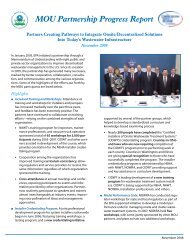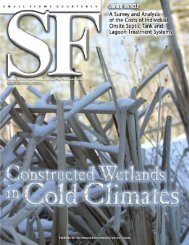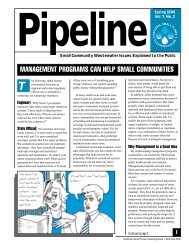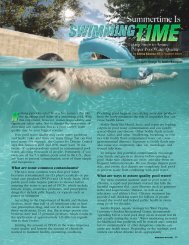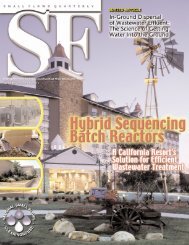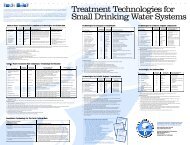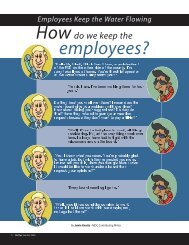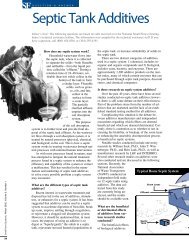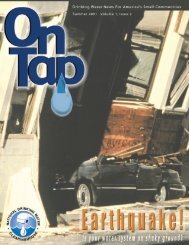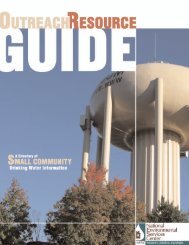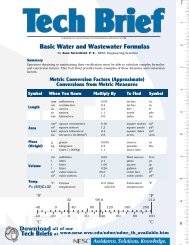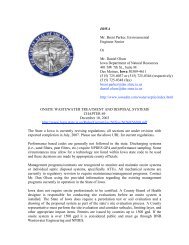Craig Mains | Technical Assistant - National Environmental Services ...
Craig Mains | Technical Assistant - National Environmental Services ...
Craig Mains | Technical Assistant - National Environmental Services ...
Create successful ePaper yourself
Turn your PDF publications into a flip-book with our unique Google optimized e-Paper software.
algal harvester will treat the wastewater. A similar pilot<br />
system has been in place in Whitestown, Indiana, since<br />
2004. The Cedar Lake facility plans to use the algae to<br />
treat municipal waste and use the sludge byproduct to<br />
produce electricity, heat, and biofuel, according to insideindianabusiness.com.<br />
Wa s t ewater treatment professionals aren’t the only<br />
ones testing algae. NASA is investing in the algal-based<br />
fuel technology, as well, conve rting astronauts’ wa s t e-<br />
water from space missions into biofuel by floating plastic<br />
bags of the fo rm e rly sky-bound sewage in sea-based<br />
nu r s e ri e s, according to a May 29, 2009, New Yo rk T i m e s<br />
a rt i c l e.<br />
The process starts with algae being placed in the<br />
sewage-filled bags, called OMEGA (offshore membrane<br />
enclosures for growing algae). The bags are semi-permeable<br />
membranes developed to recycle astronauts’ wastewater<br />
on long space missions. Once submerged in the<br />
ocean, the membrane allows freshwater out but keeps<br />
saltwater from entering. The wastewater is treated by the<br />
algae and released to the ocean. NASA then converts<br />
the algae into biofuel.<br />
What’s the future?<br />
Although the idea of combining algae and wastewater<br />
to make biofuel seems promising, the technology needed<br />
to make it profitable on a large scale may take several<br />
years to keep pace.<br />
The U.S. Department of Energy says commercialization<br />
of algal biofuels is not economically profitable with<br />
today’s technology. “Based on conservative estimates,<br />
algal biofuels produced in large volumes with current<br />
technology would cost more than $8 per gallon in contrast<br />
to $4 per gallon for soybean oil today. Lowering this<br />
cost will require coordinated R&D [research and development]<br />
across a wide range of technical sectors over the<br />
next five to 10 years. Although the technical challenges<br />
are significant, the broad public benefit of successfully<br />
commercializing algal biofuels warrants placing a high<br />
priority on the needed research,” states a Department of<br />
Energy information bulletin.<br />
Areas that need to be addressed include algal mass<br />
cultivation; control of competitors, grazers, and<br />
pathogens; system design and engineering; long-term<br />
maintenance of desired strains in a culture; and hydrodynamics<br />
of mixing, to name a few.<br />
wa s t ewater are intriguing and wo rt hy of a closer look.<br />
“I think algae could be the poster child for the integration<br />
of wastewater, drinking water and the economy. It<br />
might be a big economic piece of the puzzle. The idea<br />
has far-reaching tentacles and may even have potential<br />
benefits like carbon,” Iwan says.<br />
For more information on algae and wastewater, check<br />
out these resources:<br />
“Algal biofuels,” U.S. Department of Energy Biomass<br />
Program. Retrieved Sept. 23, 2009, at www1.eere.energy.gov/biomass/pdfs/algalbiofuels.pdf.<br />
Chang, Emily. “China Pursues Algae Power,” CNN.<br />
Aug. 23, 2009. Retrieved Sept. 2, 2009 at<br />
www.cnn.com/2009/TECH/science/08/21/eco.algaebiofuel/index.html#cnnSTCVideo.<br />
Glover, Mark. “Algae-Based Biofuel Fills Hybrid’s<br />
Tank,” Sept. 10, 2009. Retrieved Sept. 22, 2009, at<br />
www.mcclatchydc.com/nation/story/75141.html.<br />
Howell, Katie. “NASA Bags Algae, Wastewater in Bid<br />
for Aviation Fuel.” May 12, 2009. Retrieved Sept. 2, 2009,<br />
at www.nytimes.com/gwire/2009/05/12/12greenwire-<br />
nasa-bags-algae-wastewater-in-bid-for-aviation-<br />
12208.html.<br />
Insideindianabusiness.com, “Algae-Based Wastewater<br />
Treatment Plant Planned for Lake County.” June<br />
11, 2008. Retrieved Sept. 2, 2009, at www.insideindianabusiness.com/newsitem.asp?ID=29901#middle<br />
Mouawad, Jad. “Exxon to Invest Millions to Make Fuel<br />
from Algae,” The New York Times. July 14, 2009. Retrieved<br />
Sept. 8, 2009 at<br />
www.nytimes.com/2009/07/14/business/energy-environment/14fueld.html.<br />
Oliver, Charles. “DU Biodiesel Facility Will Be the First<br />
of Its Kind in the Country, Officials Say,” July 1, 2009. Retrieved<br />
Sept. 10, 2009, at www.daltondailycitizen.<br />
com/local/local_story_182174458.html.<br />
Colosi cautions also that she isn’t investing her<br />
money in the technology just yet, adding that biosolid<br />
separation needs to be perfected. “Most of the approaches<br />
used by biologists are way too energy intensive to be<br />
practical,” she says, “but there seems to be a lot of academic<br />
interest, and it’s certainly caught the attention of<br />
the public. It’s promising, but it’s also challenging.”<br />
Iwan agr e e s, adding that research needs to play a<br />
role in assessing the benefits of combining algae and<br />
wa s t ewater as a potential fuel source. Still, he says that<br />
the global economic benefits of easing Ameri c a ’s dependency<br />
on fossil fuel through a collaboration of algae and<br />
15




